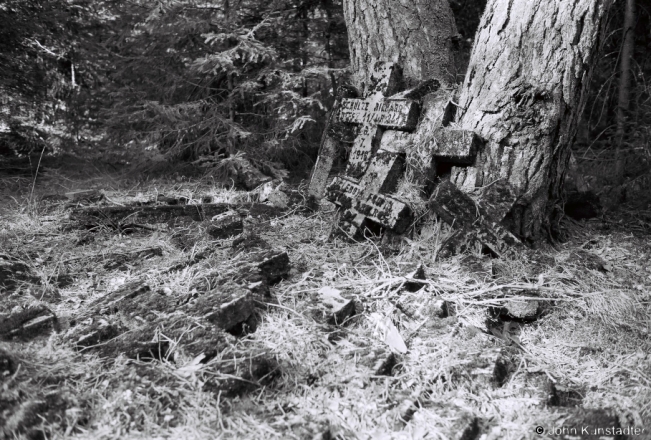Photo survey of the patrimony of Vjaljejka and Smarhon’ Districts 2018.
Фотавандроўка па спадчыне Вялейскага й Смаргоньскага раёнаў 2018 г.
World War I cemeteries (part LXXXIII): German gravestone crosses, Kalpjaja (Smarhon’ District).
Of the many German World War I cemeteries in Belarus, the cemetery and local volunteers’ placement of gravestone crosses at Kalpjaja is perhaps the most evocative of the losses in the trench warfare along the Eastern Front.
From September 1915 to November 1917 the German, Austrian and Russian imperial armies, indifferent to the rights of the Belarusian nation, contested part of the World War I Eastern Front on a static southwest to northeast line across Belarusian lands. According to Belarusian photographer-historian Uladzimir Bahdanau, during that time the German, Austrian and Russian imperial armies established more than 300 military cemeteries along this section of the front. Estimates vary from 106 to more than 150 German cemeteries which remain or whose former sites are locatable.
The Belarusian heritage and local-history site Globus Belarusi — Глобус Беларуси, globustut.by — reports that many of the crosses in the Kalpjaja World War I cemetery originally stood at German graves in the village cemetery of Ukrapjenka (Украпенка), located two kilometers northwest of Kalpjaja. See also photos of the day for March 28, 2022 (World War I Cemeteries part LXVII) for the German crosses remaining in Ukrapjenka.
The crosses in Kalpjaja appear to be the original German ones rather than replacements made by Polish authorities under contract to the German War Graves Commission (Volksbund Deutsche Kriegsgräberfürsorge — VDK or “Volksbund”) during the interwar Second Polish Republic, when Poland incorporated the western Belarusian lands, including the area around Kalpjaja.
Могілкі Першай сусьветнай вайны (частка LXXXIII): нямецкія надмагільлі, Калпяя (Смаргоньскі раён).
Мне здаецца, што з-за разьмяшчэньня крыжоў мясцовымі валантэрамі, нямецкія могілкі ў в. Калпяя, усіх нямецкіх могілак Першай сусьветнай вайны, якія засталіся ў Беларусі, найбольш выклікаюць сэнс стратаў з акопнай вайны ўздоўж Усходнім фронце.

